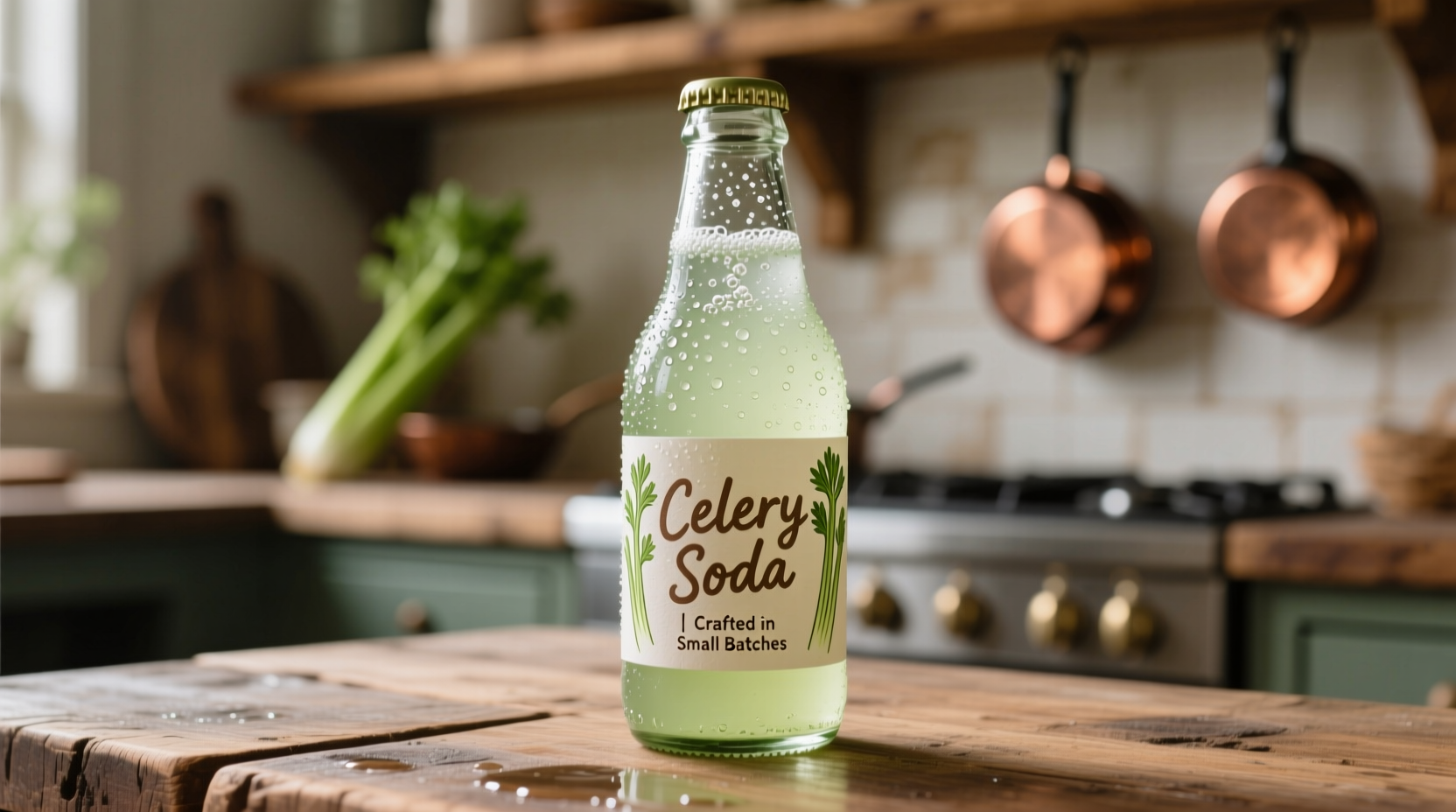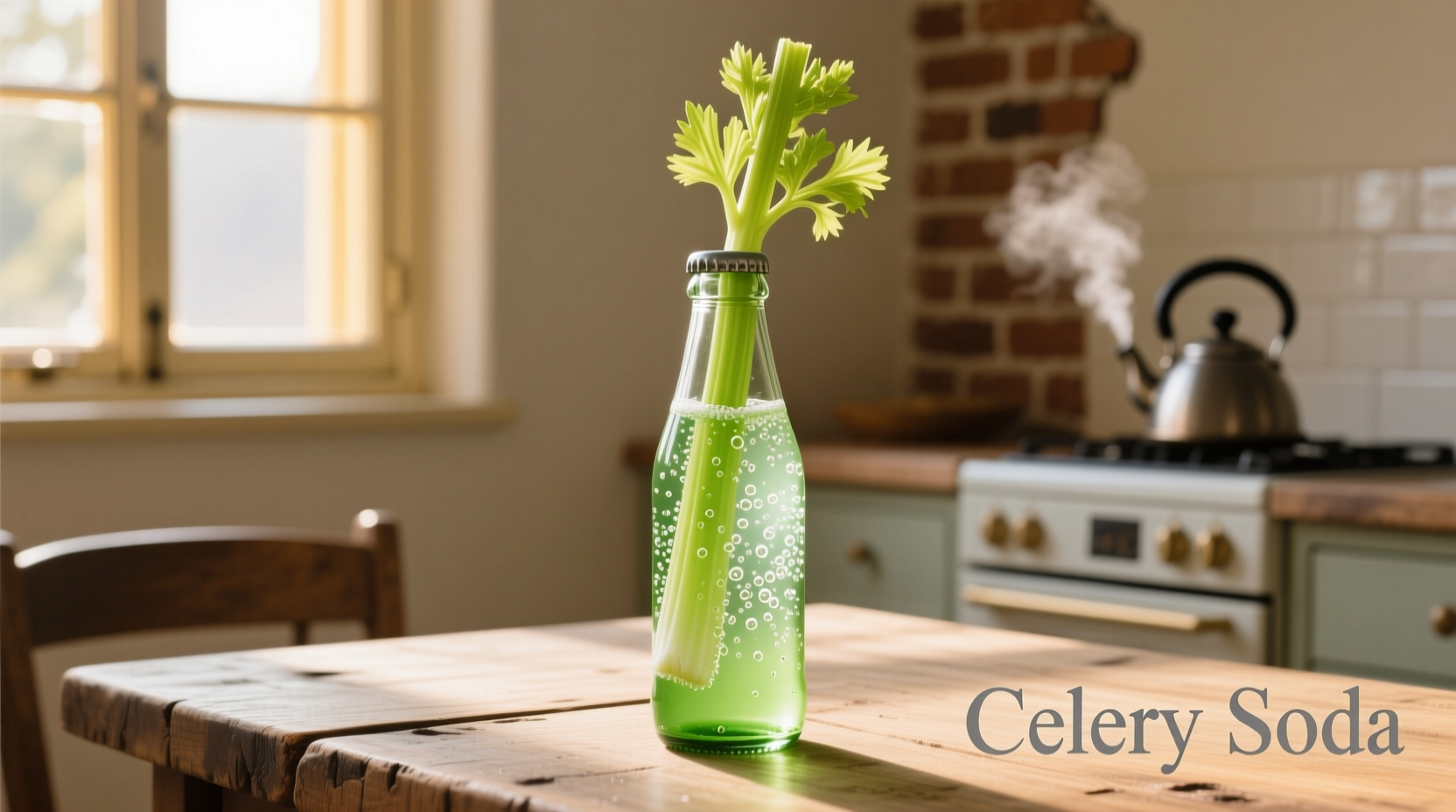Celery soda is a carbonated beverage made from celery seed extract or celery juice, offering a distinctive herbal flavor with subtle vegetal notes. Unlike plain celery juice, it contains carbonation and often includes natural sweeteners to balance celery's natural bitterness, creating a refreshing alternative to traditional sodas.
What Exactly Is Celery Soda?
When you search for celery soda, you're likely wondering how this unusual beverage differs from regular sodas or celery juice. Celery soda represents a niche category of botanical beverages that has experienced renewed interest among health-conscious consumers seeking alternatives to sugar-heavy soft drinks.
Unlike celery juice—which has gained popularity for its purported health benefits—celery soda incorporates carbonation and typically contains less concentrated celery flavor. Most commercial varieties use celery seed extract rather than fresh celery juice as the primary flavoring agent, creating a more consistent taste profile while maintaining that distinctive herbal character.
The Historical Journey of Celery Soda
Celery soda isn't a recent health trend but has roots stretching back to the late 19th century. During the "soda fountain era" (1880-1920), pharmacists and soda jerks experimented with various botanical extracts to create medicinal-tonic beverages.
| Time Period | Development | Commercial Availability |
|---|---|---|
| 1880-1920 | Created as "medicinal tonics" in soda fountains | Available at local soda fountains |
| 1920-1950 | Declined during Prohibition as soda fountains focused on "near beer" alternatives | Limited regional production |
| 1950-1990 | Nearly disappeared as cola dominance grew | Only available in specialty markets |
| 1990-Present | Revived by craft soda makers and health-focused brands | Growing availability in health food stores |
According to historical records from the Library of Congress Soda Fountain Collection, celery was among the top five botanical flavors used in early medicinal sodas, valued for its purported digestive benefits and distinctive flavor profile that cut through the sweetness of early soda formulations.
Celery Soda vs. Similar Beverages: Understanding the Differences
Many consumers confuse celery soda with other celery-based beverages. Understanding these distinctions helps you select the right product for your needs:
- Celery soda contains carbonation, moderate celery flavor, and typically 15-30g of sugar per serving
- Celery juice is non-carbonated, intensely flavored, and contains no added sugar (but higher natural sodium)
- Celery tonic refers to non-carbonated beverages with medicinal claims, often containing additional herbs
- Celery-flavored sparkling water has minimal celery flavor and no sugar
The key distinction lies in the carbonation level and flavor concentration. Traditional celery soda maintains enough celery character to be recognizable while balancing it with sweetness and effervescence—making it more approachable than straight celery juice for most palates.

How to Make Authentic Celery Soda at Home
Creating your own celery soda allows you to control ingredients and customize the flavor profile. This traditional method produces a more authentic taste than simply mixing celery juice with soda water.
Basic Celery Soda Recipe
Makes approximately 1 quart
- Prepare 4-5 fresh celery stalks, thoroughly washed and chopped (include leaves for more intense flavor)
- Simmer celery in 4 cups of water for 20 minutes until liquid reduces by one-third
- Strain liquid through cheesecloth, pressing to extract maximum flavor
- Add 1/2 cup sugar (or honey/maple syrup) and stir until dissolved
- Cool completely, then add 1/4 teaspoon celery seed extract (available at specialty food stores)
- Chill, then carbonate using a soda maker or mix with equal parts club soda just before serving
For best results, let the finished soda rest in the refrigerator for 24 hours before serving to allow flavors to meld. The celery seed extract is crucial—it provides the characteristic flavor that fresh celery alone cannot achieve in a carbonated beverage.
Where to Find Celery Soda Today
While not as widely available as mainstream sodas, celery soda has seen a resurgence among craft beverage producers. Your availability depends significantly on location and shopping preferences:
- Health food stores: Brands like Folk Soda Co. and Better Botanicals offer celery soda in select Whole Foods and natural grocery chains
- Online retailers: Several craft soda makers ship nationally, though carbonation quality may degrade during transit
- Specialty markets: Available in some European import stores (celery soda remains more popular in parts of Europe)
- DIY options: Celery soda syrups from brands like Small Hand Foods allow you to create it at home
According to beverage industry reports from BevNet, the craft soda market has grown by 12% annually over the past five years, with botanical flavors like celery representing the fastest-growing segment. However, distribution remains limited compared to mainstream sodas due to niche appeal and production challenges.
Nutritional Profile and Considerations
Understanding celery soda's nutritional content helps determine if it aligns with your dietary goals:
- Typical 12oz serving contains 120-150 calories (compared to 140 in regular cola)
- Sodium content ranges from 50-100mg per serving (significantly less than celery juice's 300mg+)
- Contains natural plant compounds including phthalides, which preliminary research suggests may support cardiovascular health
- Lacks the fiber content of whole celery but retains some water-soluble nutrients
While celery soda contains less sugar than traditional sodas, it's not a health beverage. The U.S. Dietary Guidelines recommend limiting added sugars to less than 10% of daily calories, so enjoy celery soda in moderation as part of a balanced diet.
Practical Tips for Enjoying Celery Soda
Maximize your celery soda experience with these expert recommendations:
- Serving temperature: Chill thoroughly (34-38°F) to enhance the refreshing quality and mellow any harsh notes
- Glassware: Use a tall, narrow glass to preserve carbonation and concentrate the aromatic compounds
- Pairings: Complements seafood dishes, light salads, and vegetable-based appetizers exceptionally well
- Cocktail mixer: Creates distinctive Bloody Mary variations or pairs beautifully with gin for a herbal cocktail
- Flavor enhancement: A squeeze of lemon or lime can brighten the herbal notes for some palates
Many first-time drinkers find celery soda challenging due to its distinctive flavor profile. Start with smaller servings to allow your palate to adjust, as the herbal notes become more appealing with repeated exposure.











 浙公网安备
33010002000092号
浙公网安备
33010002000092号 浙B2-20120091-4
浙B2-20120091-4